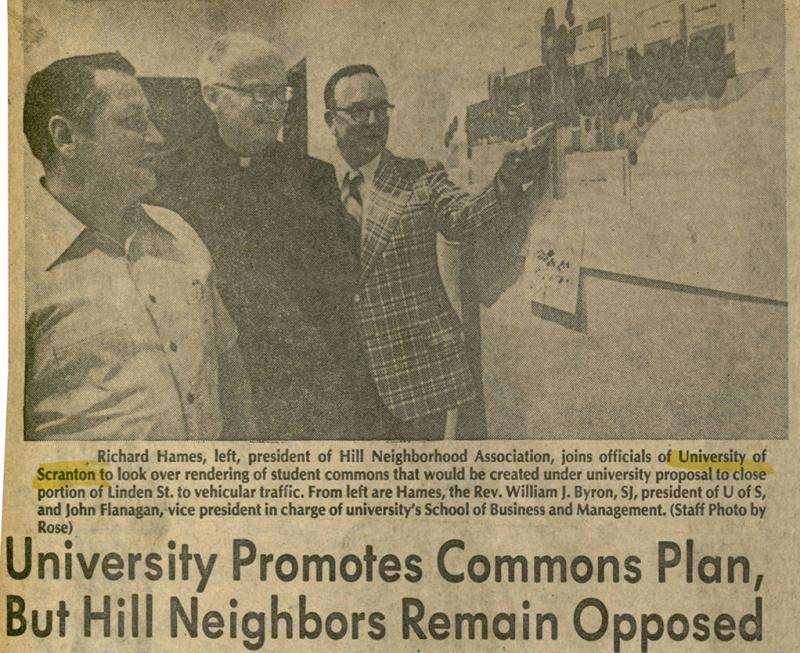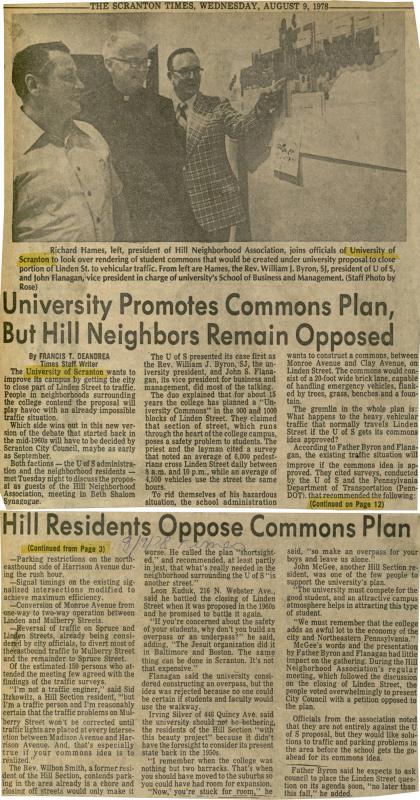University Promotes Commons Plan But Hill Neighbors Remain Opposed, 1978
Item
- Title
- Description
- Date
- Creator
- Subject
- Source
- Record Identifier
- Exhibit Section
- Copyright
- Transcript
-
University Promotes Commons Plan But Hill Neighbors Remain Opposed, 1978
-
Scranton Times article about the plans to transform a portion of Linden Street into the University of Scranton Commons.
-
1978-08-09
-
University of Scranton Archives
-
univscrapbook-b044_0126a
-
Times Shamrock Communications
-
[Please note that computer-generated transcripts include formatting, spelling, and grammatical irregularities and errors.]
THE SCRANTON TIMES, WEDNESDAY, AUGUST 9, 1978
Richard Hames, left, president of Hill Neighborhood Association, joins officials of University of Scranton to look over rendering of student commons that would be created under university proposal to close portion of Linden St. to vehicular traffic. From left are Hames, the Rev. William J. Byron, SI, president of U of S, and John Flanagan, vice president in charge of university's School of Business and Management. (Staff Photo by Rose)
University Promotes Commons Plan, But Hill Neighbors Remain Opposed
By FRANCIS T. OEANDREA
Times Staff Writer
The University of Scranton wants to improve its campus by getting the city to close part of Linden Street to traffic.
People in neighborhoods surrounding the college contend the proposal will play havoc with an already impossible traffic situation.
Which side wins out in this new version of the debate that started back in the mid-1960s will have to be decided by
Scranton City Council, maybe as early as September.
Both factions — the U of S administration and the neighborhood residents — met Tuesday night to discuss the proposal as guests of the Hill Neighborhood Association, meeting in Beth Shalom Synagogue.
The U of S presented its case first as the Rev. William J. Byron, SJ, the university president, and John S. Flanagan, its vice president for business and management, did most of the talking.
The duo explained that for about 15 years the college has planned a "University Commons" in the 900 and 1000 blocks of Linden Street. They claimed that section of street, which runs through the heart of the college campus, poses a safety problem to students. The priest and the layman cited a survey that noted an average of 6,000 pedestrians cross Linden Street daily between 8 a.m. and 10 p.m., while an average of 4,500 vehicles use the street the same hours.
To rid themselves of his hazardous situation, the school administration wants to construct a commons, between Monroe Avenue and Clay Avenue, on Linden Street. The commons would consist of a 20-foot wide brick lane, capable of handling emergency vehicles, flanked by trees, grass, benches and a fountain.
The gremlin in the whole plan is: What happens to the heavy vehicular traffic that normally travels Linden
Street if the U of S gets its commons idea approved?
According to Father Byron and Flanagan, the existing traffic situation will improve if the commons idea is approved. They cited surveys, conducted by the U of S and the Pennsylvania Department of Transportation (Penn-DOT). that recommended the following:
(Continued on Page 12)
Hill Residents Oppose Commons Plan
(Continued from Page 3)
—Parking restrictions on the north-eastbound side of Harrison Avenue during the rush hour.
—Signal timings on the existing signalized intersections modified to achieve maximum efficiency.
—Conversion of Monroe Avenue from one-way to two-way operation between Linden and Mulberry Streets.
—Reversal of traffic on Spruce and Linden Streets, already being considered by city officials, to divert most of the eastbound traffic to Mulberry Street and the remainder to Spruce Street.
Of the estimated 150 persons who attended the meeting few agreed with the findings of the traffic surveys.
"I'm not a traffic enginer," said Sid Itzkowitz, a Hill Section resident, "but I'm a traffic person and I'm reasonably
certain that the traffic problems on Mulberry Street won't be corrected until traffic lights are placed at every intersection between Madison Avenue and Harrison Avenue. And, that's especially true if your commons idea is to
realized."
The Rev. Wilbon Smith, a former resident of the Hill Section, contends parking in the area already is a chore and closing off streets would only make it worse. He called the plan "shortsighted," and recommended, at least partly in jest, that what's really needed in the neighborhood surrounding the U of S "is another street."
Leon Kuduk, 216 N. Webster Ave., said he battled the closing of Linden Street when it was proposed in the 1960s and he promised to battle it again.
"If you're concerned about the safety of your students, why don't you build an overpass or an underpass?" he said, adding, "The Jesuit organization did it in Baltimore and Boston. The same thing can be done in Scranton. It's not that expensive."
Flanagan said the university considered constructing an overpass, but the idea was rejected because no one could be certain if students and faculty would use the walkway.
Irving Silver of 446 Quincy Ave. said the university should not be bothering the residents of the Hill Section "with this beauty project" because it didn't have the foresight to consider its present state back in the 1950s.
"I remember when the college was nothing but two barracks. That's when you should have moved to the suburbs so you could have had room for expansion.
"Now, you're stuck for room," he said, "so make an overpass for your boys and leave us alone."
John McGee, another Hill Section resident, was one of the few people to support the university's plan.
"The university must compete for the good student, and an attractive campus atmosphere helps in attracting this type of student.
"We must remember that the college adds an awful lot to the economy of the city and Northeastern Pennsylvania."
McGee's words and the presentation by Father Byron and Flanagan had little impact on the gathering. During the Hill Neighborhood Association's regular meeting, which followed the discussion on the closing of Linden Street, the people voted overwhelmingly to present City Council with a petition opposed to the plan.
Officials from the association noted that they are not entirely against the U of S proposal, but they would like solutions to traffic and parking problems in the area before the school gets the go-ahead for its commons idea.
Father Byron said he expects to ask council to place the Linden Street question on its agenda soon, "no later than this fall," he added.
- Item sets

